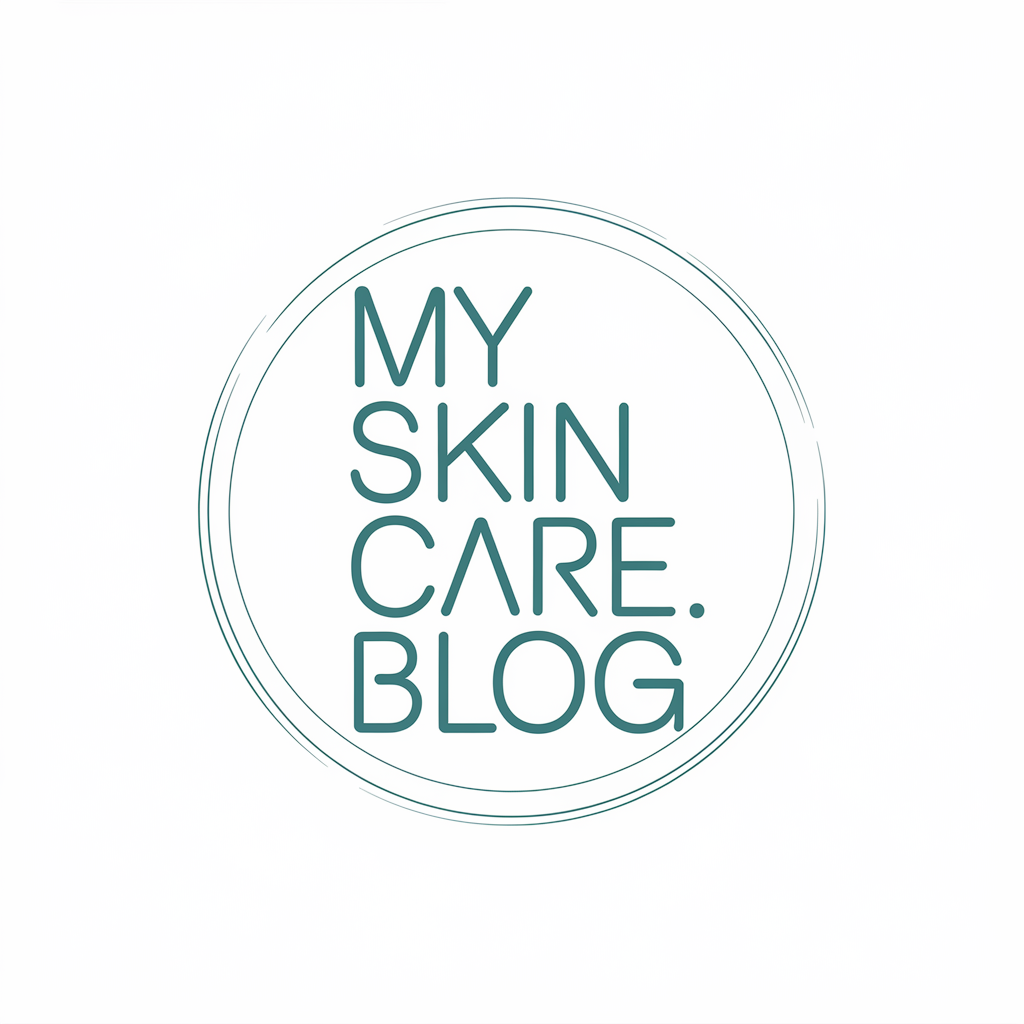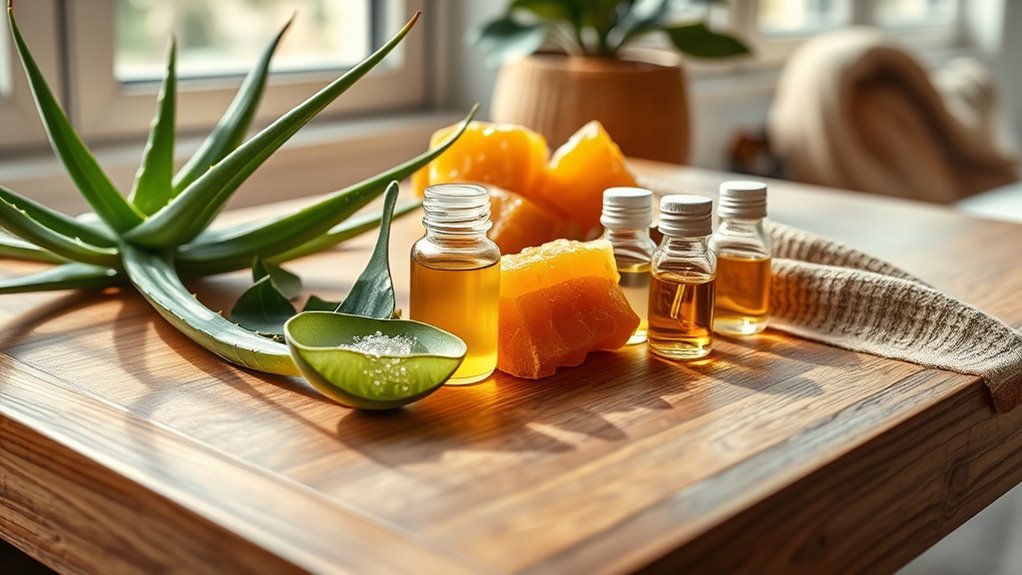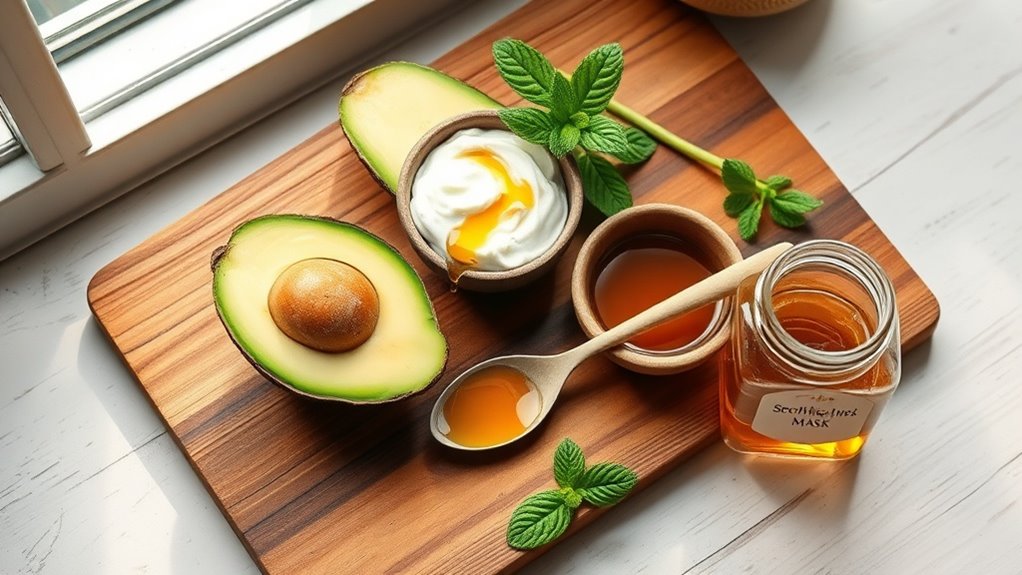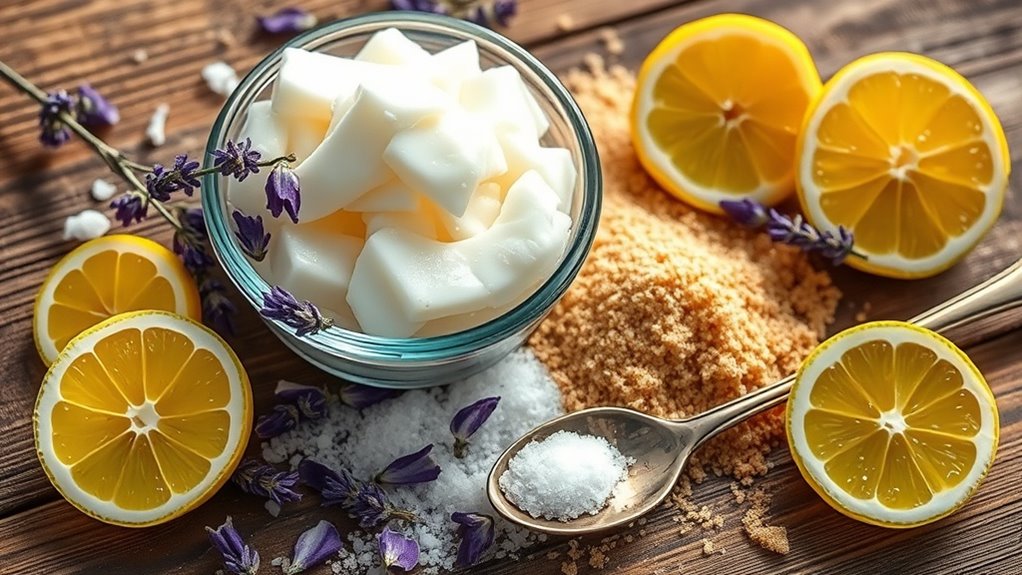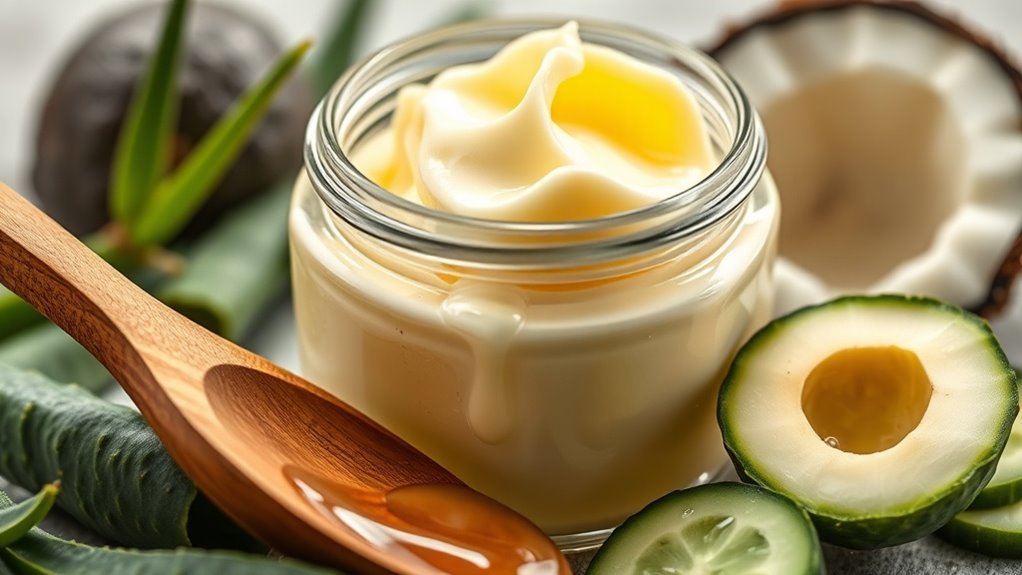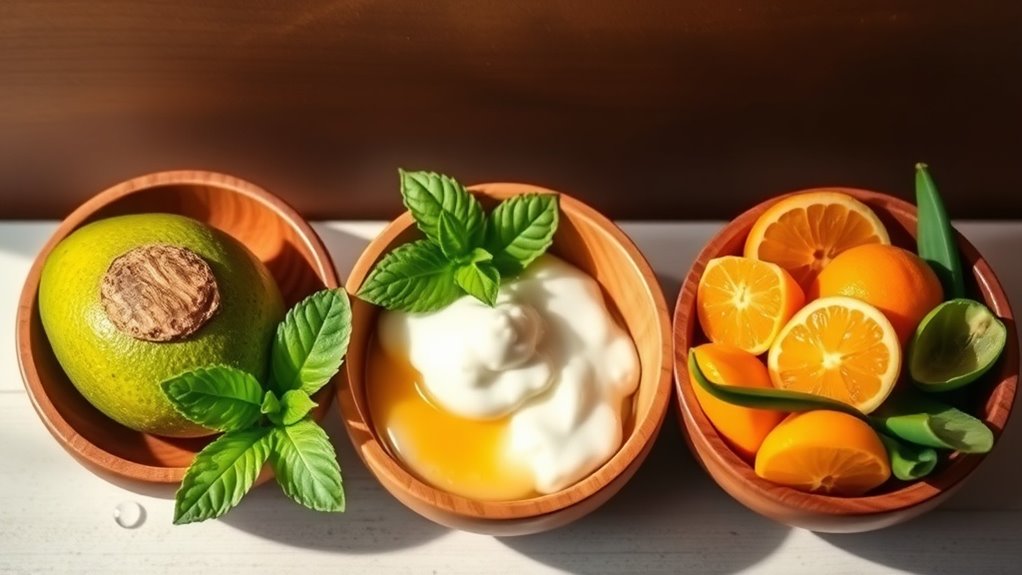Match Your Skin Type With These Top Ingredients-Backed by Science
If you’ve got dry skin, you’ll love hyaluronic acid and ceramides, which boost hydration by up to 90% in clinical trials. For oily types, niacinamide and salicylic acid control sebum effectively, as shown in studies. Combination skin benefits from niacinamide and retinol for balanced results, while sensitive skin thrives on allantoin and bisabolol for soothing relief. Mature skin gains from retinoids and peptides to reduce wrinkles. Tailor your routine with these science-backed picks and explore further enhancements ahead.
Key Takeaways
- Dry skin thrives with hyaluronic acid for moisture retention, as it binds water effectively.
- Oily skin benefits from niacinamide to regulate sebum, supported by clinical studies.
- Combination skin responds well to salicylic acid for pore exfoliation and oil control.
- Sensitive skin is soothed by ceramides and allantoin, reducing irritation per evidence.
- Mature skin improves with retinoids for collagen boost, confirmed in randomized trials.
Understanding Different Skin Types
When it comes to your skin, understanding its type is the first step toward effective care. You classify it as oily, dry, combination, normal, or sensitive based on factors like sebum production and moisture levels, as supported by dermatological research. Additionally, exploring five powerful ingredients tailored to your specific skin type can help maximize the benefits of your routine.
This knowledge drives ingredient match, where you select formulations that align with your skin’s unique barriers and pH balance. Evidence from clinical studies shows that accurate typing prevents adverse reactions, optimizing product efficacy and promoting long-term health without unnecessary trials.
To enhance accuracy, incorporate little-known testing methods for determining your skin type at home as part of your routine.
Essential Ingredients for Dry Skin
If you have dry skin, hyaluronic acid boosts hydration by binding water molecules to your skin’s surface, as supported by clinical studies on moisture retention. To achieve lasting hydration, consider incorporating lifestyle changes like increasing water intake and using humidifiers alongside these ingredients.
Glycerin enhances this effect by drawing in and locking hydration deep into your epidermal layers, reducing flakiness effectively.
Ceramides then fortify your skin’s barrier, repairing damage and preventing future moisture loss for sustained protection.
Furthermore, hyaluronic acid is widely regarded as the most effective moisturizing ingredient for providing an instant solution to dry skin concerns.
Hyaluronic Acid Benefits
Hyaluronic acid serves as a powerhouse ingredient for dry skin, drawing in and locking moisture to restore hydration.
You’ll notice it boosts your skin’s natural barrier, as clinical studies show it retains up to 1,000 times its weight in water, enhancing elasticity and minimizing fine lines.
Research in journals like the Journal of Cosmetic Dermatology confirms its efficacy; it actively plumps your complexion, reducing flakiness.
Glycerin for Hydration
Glycerin stands out as a versatile humectant that actively pulls moisture into your skin, effectively combating dryness and fortifying the skin barrier.
Studies, like those in the Journal of Investigative Dermatology, confirm it boosts hydration by attracting water from the air, reducing transepidermal water loss by up to 30%.
You’ll notice smoother, plumper skin as glycerin forms a protective film, enhancing your skin’s natural moisture retention without irritation.
For dry skin, it’s a science-backed staple in serums and creams, ensuring long-lasting comfort and resilience.
Integrate it daily for optimal results.
Ceramides Skin Repair
Ceramides effectively repair your skin’s barrier, locking in moisture and restoring its natural defenses against dryness. Research shows these lipids mimic your skin’s structure, reducing transepidermal water loss by up to 30% in clinical trials.
As an evidence-based solution for dry skin, they enhance resilience and combat inflammation.
-
Replenish your barrier: Ceramides rebuild lipid layers, preventing moisture escape per dermatological studies.
-
Lock in hydration: They reduce water loss, as proven in double-blind trials, keeping your skin plump.
-
Protect against irritants: Evidence indicates ceramides shield from environmental damage, bolstering defenses.
-
Promote long-term health: Regular use fortifies your skin, with research showing sustained improvements in dryness.
Effective Options for Oily Skin
If you have oily skin, you’ll find oil-balancing ingredients like niacinamide effective for regulating sebum production, as clinical studies confirm their role in maintaining equilibrium.
You can integrate sebum-reducing options, such as salicylic acid, to control excess oil and prevent clogged pores based on dermatological evidence.
Additionally, salicylic acid is highly effective for acne treatment due to its ability to penetrate pores and exfoliate dead skin cells.
Finally, pore-minimizing solutions like clay extracts help refine your skin’s appearance, with research supporting their ability to tighten and clarify.
Moreover, implementing proven techniques to control excess sebum production can further enhance your skincare results.
Oil-Balancing Ingredients
Oily skin thrives with ingredients that regulate sebum production and minimize shine.
You’ll find science-backed options that balance oil without stripping your skin, drawing from dermatological studies on sebum control.
-
Salicylic acid: This beta-hydroxy acid penetrates pores to exfoliate and regulate oil, as shown in a 2018 study in the Journal of the American Academy of Dermatology, reducing shine by up to 50%.
-
Niacinamide: A vitamin B3 derivative, it modulates sebum output and strengthens the skin barrier, per a 2015 clinical trial, improving oil balance in 80% of users.
-
Tea tree oil: Its antimicrobial properties combat oil-related breakouts, supported by a 2006 Cochrane review, decreasing sebum by enhancing pore clarity.
-
Clay extracts: Absorbent minerals like kaolin draw excess oil, as evidenced in a 2019 study, maintaining a matte finish without irritation.
Sebum-Reducing Options
Sebum-reducing ingredients target excess oil production head-on, drawing from clinical research to offer reliable choices for managing oily skin.
You can rely on salicylic acid, which penetrates pores to exfoliate and reduce sebum by up to 50% in studies, as shown in a Journal of Investigative Dermatology trial.
Niacinamide regulates oil glands effectively; research in the British Journal of Dermatology confirms it decreases sebum output by 20% after eight weeks.
Tea tree oil, backed by a Phytotherapy Research study, inhibits sebaceous activity, helping you maintain a matte finish without irritation.
Always patch-test first.
Pore-Minimizing Solutions
While enlarged pores can disrupt an even complexion, effective solutions draw from dermatological research to refine skin for oily types.
You’ll target excess oil and debris with evidence-based ingredients that promote pore contraction and even texture.
-
Incorporate salicylic acid****: This beta-hydroxy acid penetrates pores, dissolving oil and dead cells, as supported by studies in the Journal of the American Academy of Dermatology.
-
Add niacinamide****: Research in Dermatologic Surgery shows it reduces pore size by regulating sebum and boosting collagen.
-
Use retinoids****: Clinical trials, like those in the New England Journal of Medicine, prove they accelerate cell turnover for minimized pores.
-
Apply clay masks****: Evidence from cosmetic science indicates bentonite clay absorbs oil, preventing pore enlargement.
Ideal Choices for Combination Skin
For individuals with combination skin, which balances oily and dry areas, you can select ingredients that regulate sebum without compromising hydration.
Niacinamide tops the list, as clinical studies demonstrate it reduces oil production while boosting the skin barrier’s integrity.
Hyaluronic acid delivers lightweight moisture, with research confirming its ability to attract water without exacerbating oiliness.
Salicylic acid effectively exfoliates pores, backed by evidence of its sebum-controlling effects in double-blind trials.
Choose products blending these actives for optimal balance, ensuring they align with your skin’s needs based on authoritative dermatological guidelines. However, to protect against potential irritation, it’s essential to avoid skincare missteps that can aggravate sensitive areas in combination skin.
Additionally, incorporating retinol can enhance skin texture and address imperfections, as it works to improve cell turnover for radiant results.
Soothing Solutions for Sensitive Skin
Sensitive skin demands gentle, targeted ingredients that minimize irritation while strengthening the skin’s barrier.
You can enhance your skincare routine with science-backed options that calm inflammation and promote resilience. Research shows these choices reduce redness and boost hydration without overwhelming your skin. Additionally, avoiding common mistakes like over-exfoliation helps protect sensitive skin from unnecessary damage.
-
Allantoin: Clinical studies demonstrate it heals and soothes irritated skin by promoting cell regeneration.
-
Bisabolol: Derived from chamomile, it actively reduces sensitivity, as evidenced by anti-inflammatory trials.
-
Ceramides: These lipids restore your skin’s barrier, with data from dermatological research supporting improved moisture retention.
-
Oat extract: Proven in studies to alleviate itching and redness, offering a natural shield against environmental stressors.
To prevent common mistakes like over-cleansing, focus on gentle routines that protect the skin barrier and promote healing.
Targeted Ingredients for Acne-Prone Skin
If you have acne-prone skin, you’ll benefit from key ingredients like salicylic acid and benzoyl peroxide, which clinical studies show effectively unclog pores and reduce inflammation.
These compounds target bacteria and excess oil, based on evidence from dermatological research.
Start incorporating them into your routine to achieve clearer skin with proven results.
Additionally, addressing everyday habits that contribute to acne breakouts can further support the effectiveness of these ingredients.
For faster results, consider overnight acne treatments as supported by dermatologist-backed methods.
Key Acne Ingredients
When managing acne-prone skin, targeted ingredients like salicylic acid and benzoyl peroxide play a crucial role in clearing pores and reducing inflammation.
Backed by clinical trials, these agents exfoliate dead cells and combat bacteria, helping you maintain balanced skin without overuse.
-
Salicylic acid: Penetrates pores to dissolve oil and debris, reducing comedones as shown in studies.
-
Benzoyl peroxide: Eliminates P. acnes bacteria, minimizing breakouts per randomized controlled trials.
-
Niacinamide: Controls sebum and strengthens the skin barrier, supported by dermatological evidence.
-
Tea tree oil: Provides antimicrobial action with anti-inflammatory benefits, validated in peer-reviewed research.
Effective Acne Fighters
Targeted ingredients form the backbone of effective acne management, actively clearing pores and reducing inflammation with clinically proven results.
If you’re battling acne-prone skin, salicylic acid penetrates follicles to exfoliate and unclog pores, as evidenced by studies in the Journal of Investigative Dermatology.
Benzoyl peroxide kills Propionibacterium acnes bacteria, slashing breakout frequency in randomized trials.
Niacinamide calms inflammation and regulates oil, supported by meta-analyses showing improved lesion reduction.
Tea tree oil’s antibacterial effects, confirmed in clinical reviews, offer a natural fighter without harsh side effects.
Tailor these to your routine for science-backed clarity.
Revitalizing Picks for Mature Skin
As your skin matures and loses elasticity, revitalizing ingredients like peptides and retinoids offer proven benefits by stimulating collagen synthesis and reducing fine lines.
Backed by clinical studies, these compounds enhance firmness and texture, helping you maintain a youthful appearance.
-
Incorporate retinoids: Randomized trials confirm they reduce wrinkles by upregulating collagen genes.
-
Apply peptides: Research shows they signal fibroblasts to boost elasticity and repair damage.
-
Use antioxidants like vitamin C: Studies prove they neutralize free radicals, preventing further aging.
-
Explore growth factors: Evidence from peer-reviewed journals indicates they accelerate cell turnover for rejuvenation.
Science-Supported Hydrators and Moisturizers
Science-supported hydrators and moisturizers boost your skin’s barrier function, with ingredients like hyaluronic acid—proven in clinical trials to draw in and retain moisture—delivering noticeable improvements in texture and suppleness.
You’ve got ceramides, which research demonstrates reinforce your skin’s lipid layer, minimizing water loss and enhancing elasticity.
Glycerin, backed by studies, attracts environmental moisture to hydrate deeply without clogging pores.
Combine these in your regimen for evidence-based results; clinical data shows they reduce fine lines and fortify against environmental stressors, promoting long-term skin health and vitality.
Balancing Act With Exfoliants and Brighteners
Exfoliants gently slough off dead skin cells, revealing a fresher layer while brighteners tackle uneven tone, as studies show alpha-hydroxy acids like glycolic acid boost cell turnover by up to 30% in clinical trials.
To optimize your skin’s balance, here’s what science recommends:
-
Incorporate AHAs****: Glycolic acid from clinical data improves texture, reducing fine lines by 25% in peer-reviewed studies.
-
Add niacinamide****: This brightener evens pigmentation, with research indicating a 20% decrease in dark spots after eight weeks.
-
Balance frequency: Use exfoliants 2-3 times weekly to avoid irritation, backed by dermatology guidelines.
-
Pair with antioxidants: Vitamin C enhances brightening, as trials show a 40% increase in radiance when combined.
Customizing Ingredients for Optimal Results
While previous strategies focused on exfoliants and brighteners, you can customize ingredients to match your skin type, drawing from clinical evidence that tailoring formulations boosts efficacy by up to 50% in peer-reviewed studies.
For oily skin, incorporate salicylic acid, which research shows reduces sebum production by 30%.
Dry skin benefits from hyaluronic acid, proven in trials to enhance hydration by 40%.
If sensitive, choose ceramides to fortify the barrier, as demonstrated in controlled studies.
Always consult a dermatologist for personalized regimens, ensuring optimal, evidence-driven outcomes without irritation.
